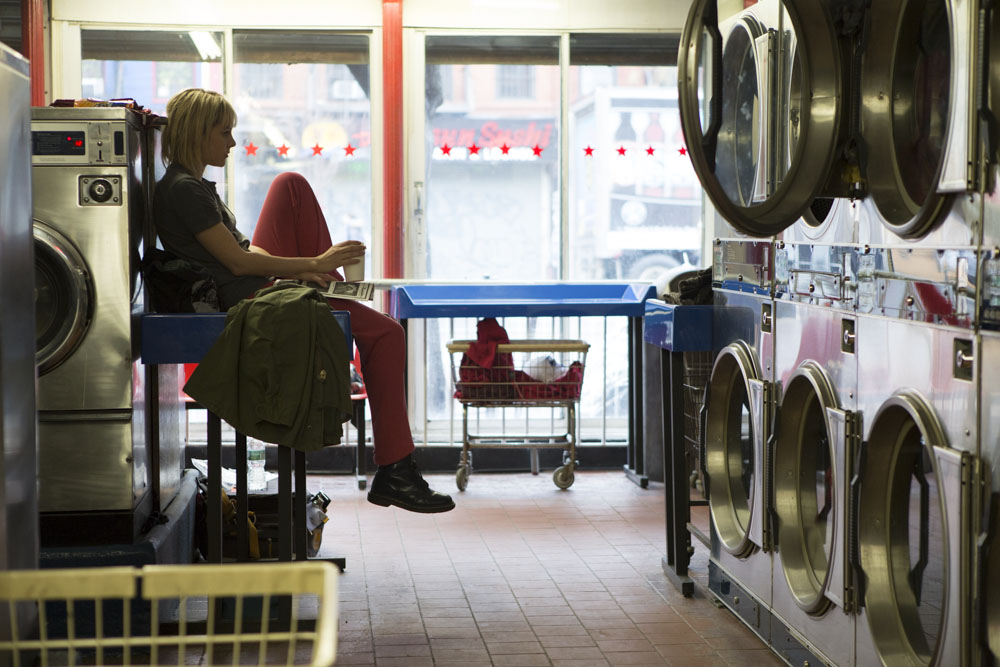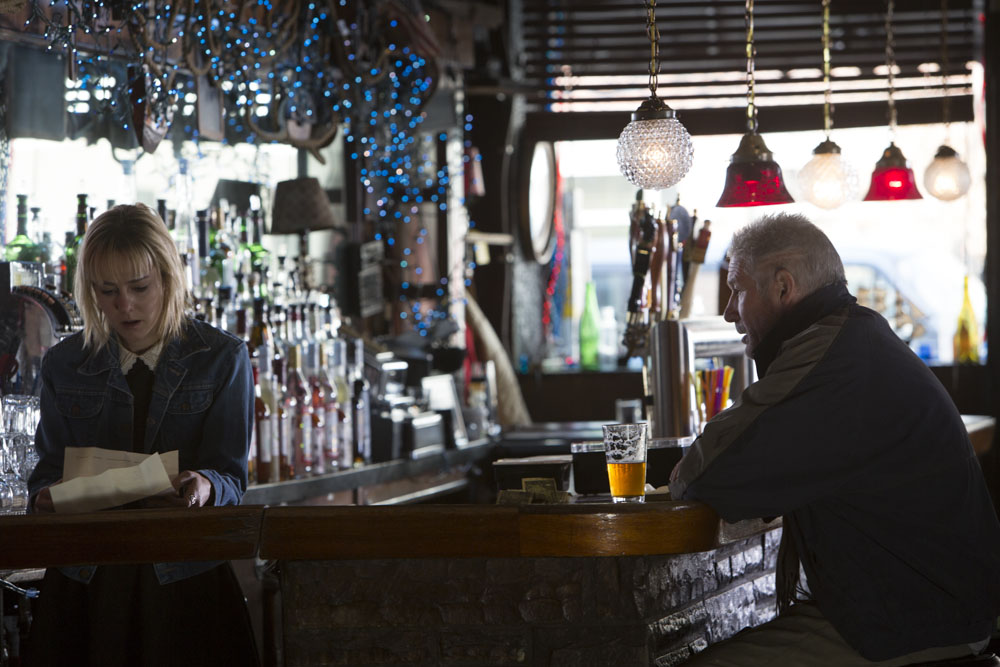
“Time Out of Mind” is the third feature written and directed by the New York independent filmmaker Oren Moverman. The movie is a chilling and exacting portrait of social negation. The story follows the downward trajectory of George (Richard Gere), a homeless man who navigates the hard streets of New York moment to moment, doing whatever is necessary to get by in finding a place to sleep, locating food or shelter.
Shooting in long takes from largely fixed perspectives, Moverman creates an eerie backdrop punctuating the man’s abject invisibility. “We don’t exist,” he says in his most despaired moments. “We’re cartoon characters.”
The documentary verisimilitude extends to the movie’s making. Moverman and his superb technical team, the excellent cinematographer Bobby Bukowski and production designer Kelly McGehee, make expressive uses of New York locations such as Grand Central Station and Bellevue Hospital. Especially in the ghostly and abstracted opening third, the dialogue is almost entirely stitched together from overheard conversations.
As he painfully illustrates the plight of George, a man increasingly trapped by a rigid bureaucracy and political institutions, Moverman subtly expands the material. He gathers extremely sharp and impressive performances from Jena Malone as a vulnerable young woman with a private connection to George and the perennially underused Ben Vereen as a jazz musician likewise trapped by choices and a nasty fate.
Moverman previously directed “The Messenger,” a bruising chamber piece about military personnel who must inform family members of soldiers killed in battle, and “Rampart,” featuring a bravura turn from Woody Harrelson as a rogue Los Angeles police officer.
He first gained recognition for his excellent adaptation of the Denis Johnson collection for Alison Maclean’s “Jesus’ Son.” He also worked with Todd Haynes on his brilliant study of the art and manner of Bob Dylan, “I’m Not There” (featuring Gere) and Ira Sachs’ murderous study of infidelity, “Married Life.”
This has been a busy year. Moverman also wrote the widely admired script of Bill Pohlad’s “Love & Mercy,” about the Beach Boys’ Brian Wilson. In an interview, Moverman talked about his new film, photography, art, working with Richard Gere and the proper ways of exploring the socially afflicted.

As the writer and director, were you interested in making a film on the socially marginalized, or did this film begin as an idea, an image, that you had?
The process itself started with Richard Gere. He actually had a script that he bought by a writer named Jeffrey Caine. It was a script that was telling a story about a homeless man. He was obsessed with the character for a very long time. I ran into him a couple of years ago and he started telling me about it. Richard started going into homeless shelters and engaging people on both sides of the issue—administrators and guards on one side and clients at the other end. He started getting into that world, and [my involvement] of wanting something Richard already started to connect this to a story.
How did you and the cinematographer, Bobby Bukowski, construct the film visually?
What we did was go with a very observational style. It’s really not a movie that tells a story in the conventional sense, although there is a story. It’s not really telling you good guys and bad guys or a film with high dramatic moments. Every step this man takes is a dramatic step in the world. The visual approach was based on the photography of Saul Leiter. He would take these very objective, observational shots of New York City but do them in a way that still felt emotionally [engaged]. So he’d shoot through windows, he’d shoot through traffic. He would shoot reflections and the subject was shot at the same time, under a canopy, and he’d let the canopy take up three-fourths of the [image] and the action of the real lives would be just one-fourth. There’d be a layering of images and the idea in a big city, you’d sort of have to make an effort to look at things or have a perspective on it.
We’re making a movie about a guy most of us ignore. Generally objective visual style that lets you through the images and through reflections but know that there’s a story going on. Once you notice this hopefully you start getting drawn into it. The style is very fixed. We shot a lot with zoom lenses. The camera almost never moves and so you get this idea of a man who’s living at his own pace, with the entire city around him.

Because of the visual style and the non-traditional mode of dramatic address, did that alter the dynamic between you and Richard? Was it different than how you worked, for instance, with Woody Harrelson in your first two films?
It was actually the same. You’re right about one thing. It is the same from my perspective. My job is to create safe environments for actors to try things. That’s how I look at it. The environment was not controlled. We basically threw Richard into these situations where he was [performing] in real life, with us very far away, shooting him, finding him at Grand Central Station, or the streets of New York, hiding the camera so we don’t have much of a subtext of a movie set, but something closer to real life.
The difference was I couldn’t control it, so I had to be much more protective of him and much more attuned. A lot of times, I’d be very far away from him but then I’d do a lot of running. I always tried to get as close as possible to the actors. It’s a very different way to shoot a movie because you’re not really sure of what is going to happen because of things that are outside of your control. Usually I try to direct in a way where we don’t know what’s going to happen but still, it’s controlled and it is within an environment where you feel like more or less like you know what is going to happen.

The movie has a documentary realism about it that some critics have compared to the work of Frederick Wiseman. That seems especially true in the material set at Bellevue.
The whole approach of the movie was there but for the grace of God goes I. With Wiseman it was about process, but some of it inside an institution, a large, complicated institution. As far as I know, we were the first film to ever be allowed to shoot inside there, the real Bellevue that was a psychiatric hospital that became an intake center for homeless men in New York City. We were allowed to shoot there for one night. We had to move very fast. What we really wanted to capture is the process. The whole movie is really a process. You meet Richard’s character George the day he becomes homeless, on the day he no longer is allowed to come back to the spot where he was squatting. He has exhausted all coaches and all friends and all the places where he could go. Really for the first time he is on his own and without a home.
He goes through the process of what would normally happen, which is going back to the place where he tried to stay and that becomes an impossibility. It’s winter in New York. He is just trying to go to a warm place. He goes to a [hospital] emergency room, and you sit there. Nobody can really throw you out, except they can if it’s over a certain temperature.
We don’t show every single moment. It was important to get into this really immersive experience. The movie works in an experiential way. You’re really walking in his shoes at times, but you’re never really him, you’re just watching him and you start to feel hopefully that once you let go of the illusion that it’s Richard Gere, that it’s actually anyone and we are all susceptible, mental illness, social abuse, all of these problems are really around the corner for any human being. Hopefully you can develop a relationship and have some compassion that you can apply to this man from various perspectives. By the end of it, you feel some kind of hope and community and family. We look out for each other, which in the end is the only way that we’re ever going to solve this problem of homelessness.
How cognizant were you of not sentimentalizing poverty or his extreme social marginalization?
Very much so. I don’t blame people who try to tell stories that tug at the heartstrings. We all need and want to feel. I think it’s emotional without being sentimental. You have to give yourself to the movie and let yourself walk the movie as it were, at its rhythm. It’s about a man who’s not living in the rhythm of running from one meeting to another or having things to do. It’s about living minute to minute. The movie had to take on that pacing without really pushing it, the patience that has to be applied like people like that. It’s the one thing you see when you go to homeless shelters or supported living facilities, patience is an incredible tool and it’s something that is very hard to have. The movie has its own patient rhythm. It would mark a misdirection to infuse that with a narrative that would squeeze emotional manipulation. We wanted to show it, the observational style worked for us.

The last seven or eight years you have worked with a number of leading independent filmmakers, like Todd Haynes and Ira Sachs, writing scripts. I was curious how that experience has shaped your own sensibility now that you are directing your own films.
It taught me more, having the director’s perspective. It’s still the same. I feel like when you’re writing and then directing, you’re working in the service of the movie and trying to create something that’s true for that movie. For me, even though you can look at some of these films and see a connection between them, for me they’re not connected. Each one is its own universe. I’ve always worked with the directors as a writer, and I’ve always considered myself a director, not in a hierarchal sense, but in the way I’m always trying to get into the head of the director I’m working with and map their vision so that I can do my job as a writer or co-writer. One feeds off the other. I started producing recently, and that’s another kind of skill set and a different kind of experience that helps me to understand the process and the whole picture of what making a movie is. You just try to keep learning no matter what position you have.
This is your third film as a director. Do you see the three as a trilogy, bound by certain themes or ideas of what you want to say about the country, the culture or social behavior?
I kind of do. All three of them are driven by male characters who are dealing with emotional turmoil with a male institution: “Messenger” was the military; “Rampart” was the police department and police corruption; this one is about male homeless shelters. The main character got older in each of the films. I do see them in a very loose way as a trilogy, and quite shocked and happy that I got into that position to say that.
Patrick Z. McGavin is a Chicago-based writer and critic. His film writing has appeared in the British magazine Empire, Stop Smiling, Time Out Chicago, Cineaste and LA Weekly. He also maintains the film blog, http://lightsensitive.typepad.com/light-sensitive.





